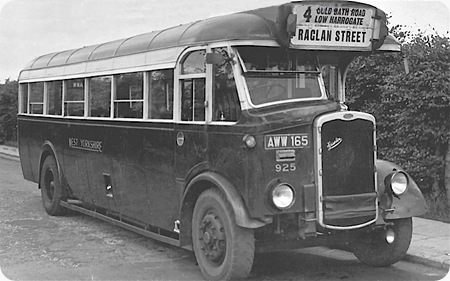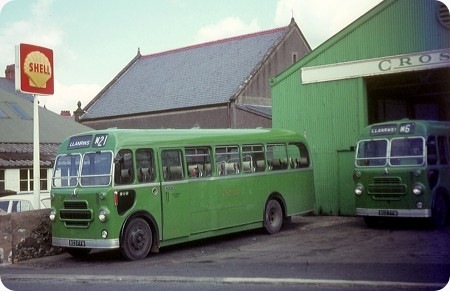Sheffield Corporation – AEC Regent III – UWE 765 – 1265
Sheffield Corporation
1955
AEC Regent III 9613S
Roe H33/25R
Sheffield bought 86 AEC Regent III in 1955/6 incorporating the new look front more usually associated with the Regent V model.
The first to arrive were a batch of 32 for the B fleet numbered 1251 – 1282 with handsome Roe bodies. 1265 is shown outside the Roe premises at Crossgates, Leeds prior to delivery. I wonder if this was the first of the batch to be completed hence the official photograph? I always felt that these were a bit heavy looking with the blue radiator surround, I believe they were referred to as ‘bluebottles’.
The total batch for the B fleet numbered 41 buses but what were to have been Roe bodied 1283 – 1291 were delivered to the A fleet as 736 – 744 and an equivalent number of the original A fleet order (bodied by Weymann) were fitted with lowbridge bodywork and took the numbers 1283 – 1291 in the B fleet. These were used to double deck the Dinnington services 6 and 19 which operated under a restricted height bridge at South Anston. Roe were quite capable of building lowbridge bodies (see other Roe product photos on this site) and I wonder why Roe didn’t simply supply the last nine as lowbridge vehicles? No doubt there was a reason for it at the time.
Although this particular bus was withdrawn in 1969, 1251 and 1254 lasted until 1973 – at 18 years old, a fair age for what was by then a low capacity obsolete (open rear platform) design. All ended up with various Barnsley area scrapmen.
A few points to note in the photograph: the difference in shading between the 12 and 65 of the front and side fleet numbers and the legal ownership by the British Transport Commission, also the missing fog lamp and the semaphore trafficator arm in front of the nearside front window.
Photograph and Copy contributed by Ian Wild
A full list of Regent III codes can be seen here.
———
30/04/11 – 06:59
I would like to help with the Sheffield J.O.C query regarding the 1955 intake of AEC Regent III buses.
At the time of the order, SJOC required 41 chassis with 9.6 litre engines and synchromesh gearboxes. An important requirement was for the "New Look" bonnet structure. At the time, the Mark V model featured a revised bonnet design, but only with the 7.75 litre engine. To meet the Sheffield request, AEC agreed to supply 41 Regent III chassis, to incorporate the "New Look" structure. C.H.Roe were to supply 41 bodies to H33/25R layout, to a height of 14ft 2 1/2ins. The modified design featured a lower deck framed in teak and upper deck in light alloy.
A problem arose when SJOC wished to increase fares on the category B services.The Yorkshire Transport Authority refused the application and the reason was that there were too many single deck services, some needing duplicate buses. The YTA suggested that more efficiency was needed, suggesting that some low height double deckers should be acquired. To this end Sheffield asked C.H Roe to modify nine of the outstanding contract to be built to low height 55 seaters. Although nine of the 41 chassis had not been delivered ALL the bodies had been built, some placed on trestles to await the chassis delivery. The result was that Weymann were asked to change an order for 45 similar Regent chassis, from H32/26R layout to L27/28R on 9 of the chassis. In consequence, Roe lettered the 9 completed buses to category A finish and the Weymann 9 lettered for the B fleet.
Keith Beeden
———
30/04/11 – 15:25
Thank you for the explanation Keith. Clear and concise as always.
John Darwent
———
30/04/11 – 20:50
Thank you Keith for that really interesting explanation about the highbridge/lowbridge body supply swap.
Ian Wild
———
02/05/11 – 12:59
Why haven’t you heard me pontificating about this picture? I’ve been away! Keith certainly answers the question of why they weren’t Regent Vs. Subsequent D3RV Regent Vs were almost identical to these Regent IIIs. It’s a shame that Roe didn’t build the low heights. The Weymann Regent IIIs and Vs were the nadir of the coach-builders art (stripped back and single skinned) and 1283 – 1291 were by far the ugliest non Utility buses ever operated by STD. Roe would have made a far better – or at least far more attractive – job of it.
David Oldfield
———
03/05/11 – 08:17
Wonderful looking vehicles these, especially in this Roe version of the Sheffield livery, and even after first repaint, when they acquired a grey roof. Perhaps the nicest sounding buses ever in the fleet, as well.
Although not visible in this view, I feel pretty certain it was this batch at least that had a white stick with a small red ball on top, attached to the top of the nearside wing, to aid drivers when pulling into the kerb, considering these ‘new look’ fronts did not afford the same view from the cab that the traditional narrower bonnet and ‘stand alone’ mudguard arrangement did. Could these have been fitted at Queens Road after suggestions from driving staff, perhaps?
Dave Careless
———
03/05/11 – 16:42
Dave, you are absolutely correct about the markers. I suspect it was a Queens Road affair because I seem to recall a few, but not all, of the Weymann Regent IIIs with markers. You can’t beat AEC/Roe for me, but these combined the musical (pre-war style) manual gearbox with the throaty exhaust. The latter disappeared with the Regent V but there were odd members of both the Regent III and V Weymanns (such as 751 and 792) which had a different gearbox which was "even more musical" – almost like the crash boxes in Guy Arab IV/V and Daimler CCG6.
David Oldfield
———
04/05/11 – 06:35
Interesting comment David, re-AEC music. I visited Paignton in 1960 when most of the Devon General services were operated by Regent/Weymanns of, I guess, about 1950 vintage. The sound was neither the melodious pre-war type crash gearbox, nor the "wail" of the manual Regent V (I know I’m liable to get lynched for calling it that), though it is some resemblance to both. It was certainly not the classic pre-selector sound either. I never came across it anywhere else, though I guess it must have been a standard transmission option.
Stephen Ford
———
04/05/11 – 06:37
I don’t remember Roe lowbridge bodies of this particular style being very numerous on AEC Regents, of course West Riding had them aplenty on Guy and Leyland. But if the Sheffield ones had been supplied by Roe, we can have a good impression of how they would have looked from the view of UWT 876 in the United Services posting, perhaps without the platform doors, but very handsome!
Chris Barker
———
04/05/11 – 06:42
I share your appreciation of the fine standard of Roe elegance coupled to the inspirational sounds of the Regent 111 9613S vehicles.751 and 792 (a D3RV type) may have been fitted with hardened gear wheels, which resulted from the earlier synchromesh problems. This modification did endow a similar whine to the Guy Arab 1V.Incidentally, at least one of the three Regal 1V/Roe single deckers, OWE 12-14 received this modification to emit Guy type sounds.
There is one more significant fact to report which relates to the 45 Regent 9613S chassis with Weymann Orion bodies, which were altered to nine to low height buses. Originally, 45 Leyland PD2/20 chassis were ordered with Orion bodies to the new "Tin Front" style. They were for the Walkley-Intake tramway conversion, due in 1956. Previously, the Leyland synchromesh gearbox featured constant mesh for 1st gear and Synchromesh on 2nd,3rd and 4th. After the contract had been signed and sealed, the Contracts engineer C.C.Hall discovered that second gear had constant mesh engagement, only 3rd and 4th having synchromesh. This was disastrous, as the Walkley and Intake routes featured some very steep hills and many of the drivers would be ex tram men. An easy change from 1st to 2nd or 3rd to 2nd was essential. Sheffield offered to pay extra to include an easy change 2nd ratio. Unfortunately, Leyland refused to provide this facility.
The outcome was that the PD2/20 order was cancelled and AEC were asked to supply 45 more 9613S chassis, in addition to the 41 already on order.
This situation was resolved by good old competition, where an alternative supplier was available!
Keith Beeden
———
05/05/11 – 06:48
As an AEC man from a boy (!) riding to aforementioned Weymann Regent IIIs and Vs on both the 95 and the 51, it shocked me to read in C C Halls excellent book that Sheffield were in fact Leyland operators who dual sourced from AEC rather than either an AEC operator or a 50/50 operator.
As I’ve said before, old age and maturity have also made me a Leyland man, but definitely second to AEC. This Leyland lack of syncro on second was very evident on the PD3s (recently posted) when setting off from rest at the bottom of Meadowhead – especially with a full load.
Interesting, though, that 43 self-same PD2/20 were delivered (with Roe bodywork) in 1957 and then 40 PD2/30 in 1957/8 divided equally between Roe and Weymann – the latter being of the type you mentioned in the cancelled order.
David Oldfield
———
05/05/11 – 06:50
It is interesting to consider different operators views on the ‘new look’ front from within the same county. Sheffield specified Regent III’s with the Regent V type front to give the vehicles a modern appearance at a time when Britain was emerging out of post-WW2 austerity. In contrast Doncaster, Leeds and Huddersfield bought Regent V’s but specified the Regent III style exposed radiator. It seems the view of these three operators was the very reverse of Sheffield’s. These three Yorkshire operators were sticking to tradition and apparently having nowt to do with modernity!
On the other hand this being Yorkshire – was the Regent III type radiator cheaper? (Provocative comment from a Lancastrian – couldn’t resist!)
Philip Halstead
———
05/05/11 – 12:16
Aye, but we’re a rum lot in Sheffield – being on the edge of outer darkness with Derbyshire. Canny wi’ brass but appreciating the finer things in life!?
David Oldfield
———
06/05/11 – 06:44
Nottingham also went for the old look exposed radiators on its 65 Regent V/Park Royals (209-273) delivered 1955/56.
Stephen Ford
———
06/05/11 – 07:04
In reply to the two David’s comments on the AEC Regent 111/Mark V with bonnet markers, I can confirm that they were fitted at Queens Road works. Some drivers complained of poor visibility to the nearside when approaching stops or close passing. During the early and mid thirties, AEC fitted this type of marker on Regent and Regal vehicles. This knowledge would be known by the engineering staff, to be produced in house.
Keith Beeden
———
06/05/11 – 07:07
Leeds took both AEC and Leyland chassis with exposed radiators for ease of maintenance. It took a change of GM to bring in enclosed radiators on both chassis and only 20 Leylands were delivered with this layout. To the very end Leeds AECs had a polished bonnet an anachronism maybe but a sight to set the juices flowing for this (then) teenager. Absolute poetry in motion!
Chris Hough
———
11/12/11 – 07:01
what about MANSFIELD DISTRICT TRACTION? Nobody hardly ever mentions these buses,also very few coloured photos about.They shared the same depot on Sutton Road Mansfield Notts.
gren




